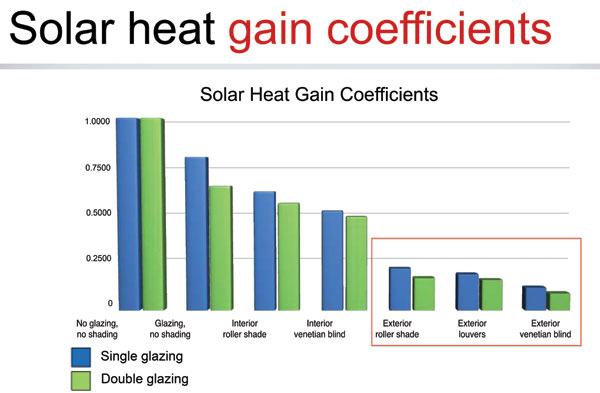Managing Heat and Light Through Exterior Shading Systems
Heat Gain in Exterior Systems
An exterior shading system broadly performs like an interior one in as much as it will reflect some solar energy, will absorb some, and will allow some to pass through it and into the interior of the building. Very little of the solar energy absorbed by the shading device, however, will pass through the glazing to the interior—most of it will be dissipated outside. This is particularly the case when low E coatings are applied to the glass. These coatings will primarily prevent long-wave radiation (heat) from passing through the glazing. Solar control low E coatings, however, can also block some short-wave radiation. If the shading is on the interior, some of the reflected solar energy can be trapped inside the building and will eventually convert into heat. If the shading is on the exterior, however, all of the reflected energy remains outside. As a result of these factors, exterior shading systems are therefore much more effective than interior ones.
Solar Heat Gain Coefficients
The increased performance of an exterior shading system can be clearly seen from the accompanying graph of solar heat gain coefficients (see the online version of this course). The solar heat gain coefficient is the fraction of the incident solar radiation admitted through a window assembly, including that which is directly transmitted and that which is absorbed and reradiated inwards. The lower a window assembly's solar heat gain coefficient, the less solar heat it transmits.
If there is an opening with no glazing, all of the solar energy passes straight through it and the solar heat gain coefficient is therefore 1.00. Installing glazing will provide some solar control. Current glazing technology means that a low solar heat gain coefficient is achievable although this often results in a significant reduction in light transmittance. Performance will be improved by the introduction of an interior shade but, as shown in the graph of solar heat gain coefficients, the impact is relatively limited. To achieve effective shading performance without the need to go to very high-performing glazing it is therefore necessary to move the systems to the exterior—with an exterior venetian blind, for example, more than 90 percent of the heat gain can be blocked before it enters the building.

Image courtesy of Draper, Inc.
Three Main Components of Solar Control
As previously mentioned, solar control involves three factors: daylighting, glare, and heat gain.
Daylighting
Designers have given much attention to daylighting in recent years. Yet it is important to fully examine the concept in order to maximize its benefits and decrease potential problems.
As Gregg Ander, FAIA, of Southern California Edison, puts it, “Daylighting is the controlled admission of natural light into a space through windows to reduce or eliminate electric lighting. By providing a direct link to the dynamic and perpetually evolving patterns of outdoor illumination, daylighting helps create a visually stimulating and productive environment for building occupants, while reducing as much as one-third of total building energy costs.”
A few phrases in this definition warrant emphasis:
▶ Controlled daylight. Letting as much light into the building as possible is not an effective daylighting practice.
▶ Dynamic illumination. People like variable daylight rather than consistent artificial light. Changing light levels give a feeling of contact with what is happening outside, irrespective of view, and can contribute towards improved productivity. To manage daylight and control glare, the shading system needs to be adjustable to take account of the sun conditions.
▶ Reduction of energy costs. Controlling daylight effectively can reduce the requirements for artificial lighting, giving significant cost savings.
Shading devices are particularly important in controlling the amount and usability of daylight in the building. This can be achieved with an interior shading system but also with an exterior one.
Glare
The amount of light that comes into the space should be sufficient to meet the needs of the people in the building but not significantly more as this can cause problems from glare. Glare has been defined by lighting experts as “the result of excessive contrasts of luminance in the field of view. The effect may vary from mild discomfort to an actual impairment of the ability to see. When the ability to see is impaired this is called disability glare. Discomfort glare is associated more with interiors; it refers to the discomfort or distraction caused by bright windows or luminaires.”
It is this discomfort glare is that is most concerning. As highlighted in the quote, one source of this glare is bright windows. By using shading systems to modulate light at the window, contrast between the window and the immediate surroundings where someone is working can be reduced, eliminating or significantly reducing the impact of glare.
Depending on the exterior system used, this goal might be achievable. The use of operable shading systems, particularly in conjunction with automated controls, can be very effective in managing daylight and glare. With certain systems, however, interior shading systems will also be required to manage light and glare. This may be the case, for example, with an exterior venetian blind. It is possible that the system will be left in the retracted position during the winter months to allow free solar gain into the building, reducing heating requirements. In these circumstances, an interior system will be required to control daylight and glare.









